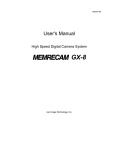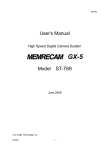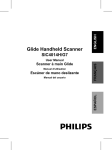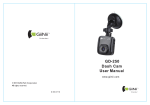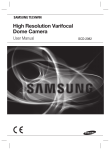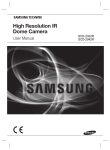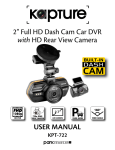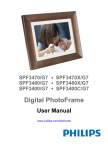Download Philips SIC 3608S/G7 User's Manual
Transcript
SIC 3608S/G7 Digital camera with swivel lens User manual Thank you for purchasing the Philips SIC 3608S/G7 digital camera where we encourage you to... “do the swivel!” Capturing photos your way. Enjoy the independence of snapping perfect self-portraits the first time. Simply swivel the lens to the back to preview your shot in the LCD display to make sure everyone is in the frame, say cheese and snap away. Or swivel the lens to the front and side to take photos from different angles. Be creative! Front swivel Side swivel Back swivel Shooting others Stealth mode Self portraits Contents I Getting to know your camera 1. Camera views 1.1 Rear panel view 1.2 Top and front camera view 2. Monitor display icons Ii. Before you shoot – camera preparation & setup 3. Batteries 3. 1 Insert the batteries 4. External SD memory card 4.1 Insert the memory card 5. Camera setup a) Set the onscreen language b) Set the current date and time c) Auto power off d) Play logo E) “Buzzer” -turn on/off beep sounds F) Adjusting the light frequency setting F2) Return to default settings G) Firmware version & updating the camera Ii. Basic photography 6. Photo image options 6.1 Photo resolution 6.2 Photo quality 6.3 White balance 6.4 Datestamp 6.5 Color effects 7. Shooting photos 7.1 Flash options 5 5 5 5 6 6 6 6 7 7 7 7 8 8 9 9 10 10 11 11 12 12 13 13 14 15 15 16 xx 7.2 Digital zoom 7.4 Burst snapshot mode 7.5 Exposure compensation Iii. Video & audio recording 8. Video recording 8.1 Video recording options A) Resolution B) Frame rate C. White balance D. Video with or without audio 9. Audio recording Iii. Photo review & video playback 10. Viewing photos on the camera lcd display 10.1 Viewing thumbnails 10.2 Zooming in on a photo 11. How to delete photos, videos & audio recordings 11.1 Formatting an sd memory card 12. Video playback 12.2 Watching videos or listening to audio recordings on your television: A) Adjusting the camera’s video output ii. Downloading photos, videos and audio recordings to your computer 13.1 Setting the camera to usb mode 13.2 Downloading photos, videos & audio recordings to a PC 13.3 Downloading photos and videos to a mac computer Iii. Maintenance 15. Camera maintenance 16. Batteries 17. SD memory card 17 18 19 20 20 20 20 21 22 22 22 23 23 23 23 24 24 25 26 27 27 27 28 28 30 30 31 32 17.1 Formatting an sd memory card 18. Camera safe-handling Iv. Camera specifications & software minimum requirements: Camera specifications Pc-Cam software minimum requirements 32 33 34 34 34 Getting To Know Your Camera 1. Camera Views 1.1 Rear Panel View 1 2 3 4 5 6 7 8 9 10 11 12 13 14 15 16 17 18 19 20 21 Left navigation flash on/off stick OK button Photo/video mode button Up navigation stick Right navigation/selftimer stick Down navigation stick Zoom in rocker button Zoom out rocker button Delete button Playback button Connection for hand strap LCD display screen USB connection Tripod socket Power indicator light Battery cover Shutter button Power button SD memory card card cover Camera lens Camera flash 5 LCD Display Icons Photo/Video Mode Photo Resolution UL XL L M S White Balance AWB Flash Mode A Photo Quality Memory Card Inserted Datestamp On Photos taken/Photo capacity 50 / 100 Battery Usage Selftimer Digital Zoom 10s 20s T 3.3 W II. Setting Up Your Camera 3. Batteries The SIC 3608S/G7 uses three (3) AAA alkaline or rechargeable batteries. 3.1 Insert the Batteries Open the battery cover by sliding it to the outside of the camera. Load the batteries according to the polarity illustration (+) and (-) on the inside of the battery door. 6 4. External SD Memory Card The SIC 3608S/G7 has 32 MB of internal memory so you can save a couple of photos on your camera, but you will want to be able to take many photos. To expand the number of photos you can shoot and store, use an external SD memory card. The camera is compatible with up to 8GB storage capacity SD cards. 4.1 Insert the Memory Card Carefully insert the SD memory card into the card slot on the top of the camera. Push the card into the slot until it locks into place. If the card does not lock into place, turn the card around, as it will only seat itself when the card is inserted correctly. 5. Camera Setup You may want to setup the camera to your preferences and to use other camera features. Language Language Francais Deutsch Italiano Espanol A) Set the Onscreen Language To set the onscreen language: 1) Press the OK button by pressing in LEFT: Exit on the center of the navigation stick. 2) Press the navigation stick to Right to display the Setup menu. 3) Press navigation stick Up or Down to highlight Language and press OK. 4) Press the navigation stick Up or Down to highlight the language you choose and press OK. 5 Press the navigation stick to the Left TWICE to exit. 7 B) Set the Current Date and Time It is useful to have the correct date and time on the camera. When you transfer photos to your computer, the date and time is listed in each photo’s information data. Date/Time 2010 / 01 / 06 AM 01 : 48 OK: Exit 1) Press the OK button 2) Press the navigation stick to Right to display the Setup menu 3) Press navigation stick Up or Down to highlight Date/Time and press OK. 4) The Year will be highlighted. Press the navigation stick Up or Down to display the current year. 5) Press the navigation stick to the Right to highlight the month. Press the navigation stick Up or Down to display the current month. 6) Repeat Steps 5 and 6 to set day, hour and minutes. 7) Press the navigation stick Right to make any corrections. 8) Press OK when done. 9) Press the navigation stick to the Left TWICE to exit. C) Auto Power Off To extend the battery life, the camera can be set to automatically turn off, if no buttons are pushed for a certain length of time. Auto Power Off Disable 60 Sec. 120 Sec. LEFT: Exit 1) Press the OK button 2) Press the navigation stick to Right to display the Setup menu. 3) Press the navigation stick Up or Down to highlight Auto Power Off and press OK. 4) Press the navigation stick Up or Down to highlight the amount of time that the camera is idle before it automatically 8 powers off (after 60 or 120 seconds). Choose Disable to stop the camera from turning off automatically. 5) Press OK. 6) Press the navigation stick to the Left TWICE to exit. D) Play Logo The camera will play a logo when powering on.You can choose to play the logo or to leave the display blank. 1) Press the OK button. 2) Press the navigation stick to Right to display the Setup menu. 3) Press the navigation stick Up or Down to highlight Play Logo and press OK. 4) Press the navigation stick Up or Down to highlight Disable to stop the camera from displaying the logo. Highlight Enable to turn the feature on and play the logo when powering on the camera. 5) Press OK. 6) Press the navigation stick to the Left TWICE to exit. E) “Buzzer” -Turn On/Off Beep Sounds The camera can be set to “beep” when a button is pushed or disabled 1) Press the OK button 2) Press the navigation stick to Right to display the Setup menu. 3) Press the navigation stick Up or Down to highlight Buzzer and press OK. Press the navigation stick Up or Down to highlight Enable to turn on audible beep sounds. Highlight Disable to turn off the audible beeps when pressing 9 4) Press OK. 5) Press the navigation stick to the Left TWICE to exit. F) Adjusting the Light Frequency Setting Photos and video can be affected by the flickering of fluorescent lights. It is best to make sure the camera is set to the right electrical frequency for your country. 1) Press the OK button if necessary, press the navigation stick to Right to display the Setup menu. 2) Press the navigation stick Up or Down to highlight Light Frequency and press OK to display the submenu. 3) Press the navigation stick Up or Down to highlight 60 Hz for TVs in North America; highlight 50 Hz for Europe. 4) Press OK. 5) Press the navigation stick to the Left TWICE to exit. F2) Return to Default Settings To reset the camera to its original default settings: 1) Press the OK button 2) Press the navigation stick to Right to display the Setup menu. 3) Press the navigation stick Up or Down to highlight Default Settings and press OK. 4) Press the navigation stick Up or Down to highlight Load to reset the camera to its original settings. Highlight No to cancel the reset or press the navigation stick to the Left to exit the menu. 5) Press OK. 6) Press the navigation stick to the Left TWICE to exit. 10 G) Firmware Version and Updating the Camera Video Setup To display the firmware version: Firmware Version 1) Press the OK button 2) Press the navigation stick to Right to display LEFT: Exit the Setup menu. 3) Press the navigation stick Up or Down to highlight Firmware version and press OK. 4) The firmware version and last update will be displayed on screen. 5) Press the navigation stick to the Left TWICE to exit the image menu 6) Press OK To update the camera’s firmware: To update the camera to the newest available firmware using a USB cable to your computer or an SD card, select Upgrade on the firmware version page. II. Basic Photography To begin shooting photos in the default mode: 1) Press Power button to turn on camera. 2) Press down the Shutter button to take photo. Note: • Once the shutter has been released, wait until the camera has saved the image and is ready to shoot, before removing the memory card or battery. Removing the battery or memory card prematurely will stop the photo from being saved. 11 • If no buttons have been pushed on the camera for more than 30 seconds, the LCD display will turn off in order to prolong battery life. Press any button to restore the image on the LCD viewfinder display. 6. Photo Image Options 6.1 Photo Resolution Photos can be shot at various resolutions up to 5 megapixels (MP). Full 5 MP resolution is best for large, printed photos. Lower resolutions –below 2 MP—are best suited to for web use and viewing on computers. To choose the resolution for Resolution 3264 x 2488 a photo: 2592 x 1944 1) Press the OK button 2048 x 1536 2) Highlight the Image menu. 1280 x 960 640 x 480 3) Press the navigation stick Up or LEFT: Exit Down to highlight Resolution and press OK. 4) Press the navigation stick Up or Down to highlight the desired resolution: 3264X2448(8M)/2592X1944(5M)/ 2048X1536(3M)/1600X1200(2M)/1280X960(1.3M) /640X480 (VGA). 5) Press OK. 6) Press the navigation stick to the Left TWICE to exit. 12 6.2 Photo Quality Photos can be compressed so that you can save a larger quantity of photos to a memory card. However, the more the photo is compressed, the lower the image quality. To conserve memory, use a lower photo quality to create a smaller file size. Normal quality photos may also be appropriate for photos used only for the web, computers or mobile phones. Use the Super Quality setting for print photos and large print photos. 1) Press the OK button 2) Highlight the Image menu. 3) Press the navigation stick Up or Down to highlight Quality and press OK to display the submenu. 4) Press the navigation stick Up or Down to highlight the desired quality: Super, Fine, or Normal 5) Press OK. 6) Press the navigation stick to the Left TWICE to exit. 6.3 White Balance Although imperceptible to the human eye, outdoor light and indoor light take on different hues. A photo taken outdoors can appear blue: an indoor photo may have a yellow cast. This is called “white balance.” The camera defaults to automatically set the white balance. However, if a photo does not display the colors correctly, or to set the camera manually for a different white balance, you can manually choose: Day Light for outdoors; Tungsten or Fluorescent indoor lighting, or Cloudy for outdoor overcast shooting. To set the white balance: 13 White Balance 1) Press the OK button Auto 2) Highlight the Image menu. Day Light 3) Press the navigation stick Up or Down Tungsten Fluorecent to highlight White Balance and press Cloudy OK to display the submenu. LEFT: Exit 4) Press the navigation stick Up or Down to highlight the desired quality: Day Light, Tungsten, Fluorescent, Cloudy, or to return the camera to Auto – to let the camera automatically adjust the white balance. 5) Press OK. 6) Press the navigation stick to the Left TWICE to exit. 6.4 DateStamp Once the date and time have been set, you can choose to have the date visible as part of the photo image by enabling the DateStamp feature. To turn on or off the DateStamp feature: 1) Press the OK button 2) Highlight the Image menu. 3) Press the navigation stick Up or Down to highlight DateStamp and press OK to display the submenu. 4) Press the navigation stick Up or Down to highlight Enable to display the date on the face of the photo, or Disable to turn off the visible date. 5) Press OK. 6) Press the navigation stick to the Left TWICE to exit. 14 6.5 Color Effects The Color Effects adjustment allows you to shoot black and white photos, or antique-looking Sepia toned photos. 1) Press the OK button. 2) Highlight the Image menu. 3) Press the navigation stick Up or Down to highlight Color Effect and press OK to display the submenu. 4) Press the navigation stick Up or Down to highlight the desired color effect. Highlight Color for normal photography; highlight Sepia for old-fashioned style photography, or highlight Monochrome for black and white photos. 5) Press OK. 6) Press the navigation stick to the Left TWICE to exit. 7. Shooting Photos 7.1 Flash Options There are three (3) flash options. Automatic Flash, Flash On and Flash Off. Use the Auto flash mode, to allow the flash to fire when the camera senses low light. Use Flash ON outdoors when shooting a subject that is in the shadows, or if a subject is backlit, or if it is an otherwise dark scene. Use Flash OFF to prevent the flash from firing in scenes where it might wash out a subject that is close to the camera, for night scenes, or for mood scenes like those lit by candle or fire light. 15 To change the Flash Mode: While in PHOTO mode, press the navigation stick to the Left. Each press left will cycle through the Flash Modes. The flash mode will be displayed on the LCD viewfinder as follows: A Auto: Automatically turn on/off Flash on: Force the flash on Flash off: Force the flash off Note: • When the Flash is in Auto or On mode, the LCD viewfinder screen will be blank after the flash has fired and is charging. Wait until the charge is complete and an image appears in the viewfinder before shooting another photo. • Shooting in bright environments with the flash turned on can result in incorrect exposure. • The flash will not function in “Burst snapshot” mode. • To prolong battery life, the flash will not function when the battery is low. 16 7.2 Digital Zoom The SIC 3608S/G7 is equipped with a 4x digital zoom to enlarge distant images and make them appear closer. To zoom in or zoom out: While in PHOTO mode, Zoom In by pressing the zoom + button. To Zoom Out again, press the zoom (-) button + Note: Using a digital zoom can result in loss of picture quality. Look at the LCD Viewfinder to determine the quality of the photo to be taken. 7.3 Self-Timer The self-timer sets the camera to release the shutter after either 10 seconds or 20 seconds, allowing the photographer to join others in a photo. Or it can be used to reduce the possibility of shaking the camera at the time the photo is taken. While in PHOTO mode, 1) Press the OK button 2) Highlight the Image menu. 3) Press the navigation stick Up or Down to highlight Selftimer and press OK to display the submenu. 4) Press the navigation stick Up or Down to highlight the desired length of time between pressing the shutter release and when the picture is taken. Choose 10 sec, 20 sec or Disable to return to normal picture taking. 5) Press OK. 6) Press the navigation stick to the Left TWICE to exit. 17 To take the photo using the self-timer: 1) Compose the picture in the LCD viewfinder. 2) Be sure that the camera is on a tripod or sturdy surface. 3) Press the shutter release button. 4) Get into the picture and wait for the picture to be taken. 7.4 Burst Snapshot Mode Use the Burst Snapshot Mode to rapidly shoot three photos in a row. This fast-action mode is perfect for sports, for capturing candid shots of children playing, or for shooting photos of animals. While in PHOTO mode, 1) Press the OK button. 2) Highlight the Image menu. 3) Press the navigation stick Up or Down to highlight Burst Snapshot and press OK to display the submenu. 4) Press the navigation stick Up or Down to highlight Burst to shoot three photos in a row. Highlight Single for normal photography. 5) Press OK. 6) Press the navigation stick to the Left TWICE to exit. To take photos in Burst Snapshot Mode: Press and hold down the shutter button until you have heard the shutter release to take 3 photos. Wait until the an image returns to the LCD Viewfinder display to show that the camera has saved the photos.You may then take more photos in Burst Snapshot. 18 Note: Using the Burst Snapshot Mode will quickly fill up camera memory by taking multiple shots. 7.5 Exposure Compensation The SIC 3608S/G7 automatically exposes each photograph by averaging the bright areas and dark areas in a photo. When a photo has a big range of bright light and dark shadows, details can disappear in bright or dark areas of the photo. Exposure compensation allows you to add or subtract exposure when taking photos so that you can better see details in bright or dark areas of the image. While in PHOTO mode, 1) Press the OK button 2) Highlight the Image menu. 3) Press the navigation stick Up or Down to highlight Exposure and press OK to display the submenu. 4) Press the navigation stick to the Right to add exposure-brightening up the image to show details in dark shadows. Press the navigation stick to the Left to subtract the amount of exposure—to darken an image that is too bright. 5) Press OK to set and exit. Note: Be sure to return to the menu and reset the exposure to +0.0 to insure proper exposure of subsequent photos. 19 III. Video and Audio Recording 8. Video Recording To record video: 1) Press the Power button to turn on the camera then press the Mode button to select VIDEO mode. 2) While in video mode, press the Shutter button to start recording video. 3) Press the Shutter button a second time to stop recording video. Note: • The LCD Viewfinder will blink red while the camera is recording. • While the camera will record audio with the video, the camera speaker does not support audio playback so you will not hear audio when viewing video on the camera. However, the audio will be heard during video playback on a TV or computer. 8.1 Video Recording Options A) Resolution You can set the video quality and size. Using a higher resolution will create larger files and use up more memory, but will give you a larger, clearer picture when played back on a computer or television. 20 To set the video resolution: While the camera is set to Video Mode, 1) Press the OK button by pressing in on the center of the navigation stick. 2) Highlight the Video menu. 3) Press the navigation stick Up or Down to highlight Resolution and press OK to display the submenu. 4) Press the navigation stick Up or Down to highlight 640 x 480 for higher resolution video, or 320 x 240 for smallersized videos. 5) Press OK. 6) Press the navigation stick to the Left TWICE to exit. B) Frame Rate For smooth video the camera can be set to shoot 30 frames per second. To save memory, you can shoot at 15 frames of video per second. For videos used online, or on a small screen 15 frames per second may be adequate. For playback on a TV, choose 30 frames per second. While the camera is set to Video Mode, 1) Press the OK button. 2) Highlight the Video menu. 3) Press the navigation stick Up or Down to highlight Frame Rate and press OK to display the submenu. 4) Press the navigation stick Up or Down to highlight 30FPS to record at 30 frames per second, or 15FPS to record at 15 frames per second. 5) Press OK. 6) Press the navigation stick to the Left TWICE to exit. 21 C. White Balance See section 6.3 for explanation of White Balance. To change White Balance in video recordings, be sure the camera is in VIDEO Mode and make White Balance changes in the Video menu in the same way that it is changed for still images. D. Video With or Without Audio Video can be recorded with or without audio. To change the audio setting: While the camera is in VIDEO Mode, 1) Press the OK button 2) Highlight the Video menu. 3) Press the navigation stick Up or Down to highlight Audio and press OK to display the submenu. 4) Press the navigation stick Up or Down to highlight Enable to record audio with the video, or Disable to record video only. 5) Press OK. 6) Press the navigation stick to the Left TWICE to exit. 9. Audio Recording The SIC 3608S/G7 can also record audio without video. 1) Press the Power button to turn on the camera. 2) Press the Mode button to select AUDIO mode. 3) Press the Shutter button to start recording audio. 4) Press the Shutter button a second time to stop recording audio. 22 Note: When recording, the LCD viewfinder will blink red and start a recording timer. The timer will display until the recording is stopped. III. Photo Review and Video Playback 10. Viewing Photos on the Camera LCD Display To view the photos you have taken, Press the Playback button. Press the navigation stick Left or Right to scroll through the photos. 10.1 Viewing Thumbnails To quickly search through photos, you can display a grid of thumbnails of the saved photos. To view thumbnails: While in PLAYBACK Mode: 1) Press the Zoom out (-) button. 2) Press the navigation stick UP/DOWN/LEFT/ RIGHT to select a photo. 3) Press the OK button to view the photo in full screen. 10.2 Zooming In on a Photo While viewing a photo, zoom in to enlarge a portion of the image on the LCD display. While in PLAYBACK Mode: 1) Press the Zoom In button to make the image appear larger. + 23 2) Press the navigation stick UP/DOWN/LEFT/RIGHT to view different enlarged portions of the photo. 3) Press the Zoom out (-) button to return to normal viewing of the photo. 11. How to Delete Photos, Videos and Audio recordings While in PLAYBACK Mode: 1) Press the Delete button to enter the DELETE mode There are three options: • Delete current – deletes the photo or recording being displayed • Delete All – deletes all photos and recordings saved on the memory card • Do not delete – cancels the deletion. 2) Press the navigation stick UP or DOWN button to choose to delete the photo or recording being displayed, or to delete all photos, videos and audio recordings, or to cancel the deletion. 3) Press the OK button. 4) Press the navigation stick to the LEFT to select Yes to confirm the deletion. 5) Press the OK button to delete the file. 11.1 Formatting an SD Memory Card An inserted SD card may need to be be formatted because: • It hasn’t been formatted before and a message appears on the camera’s LCD display to format the SD card. • The card is corrupted and is unable to be read by the camera or your computer. 24 • To delete all saved photos, videos & audios saved to the SD card. To format an SD Card: 1) Press the OK button 2) Press the navigation stick to Right to display the Setup menu 3) Press navigation stick Up or Down to highlight Format and press OK. 4) Press the navigation stick Up or Down to highlight the YES and press OK to confirm. 5) Press the navigation stick to the Left TWICE to exit. Note: ALL saved photos and files will be deleted when an SD card is formatted. 12. Video Playback You can view the saved videos without sound on the camera. 12.1 Watching Videos on the Camera’s LCD Display: While in PLAYBACK Mode, 1) Press the navigation stick to the LEFT or RIGHT to select the desired video file for playback. 2) Press the OK button to play video file. 3) While watching the video, hold the navigation stick to the RIGHT to fast forward; hold the navigation stick to the LEFT button to rewind. 4) Press the OK button a second time to stop playback. 25 12.2 Watching Videos or Listening to Audio Recordings on Your Television: Connect the SIC 3608S/G7 to your television to watch your videos or listen to your audio recordings so that you can share your recordings with others. To watch videos or view photos on your television: 1) Connect the camera to your TV using the AV cable. Be sure to match the yellow (video) and the red and white (audio) cables to a connection on your TV. 2) Power on the camera and press the Mode button to enter the PLAYBACK mode. 3) Power on the television and change its input to that which is connected to the camera. 4) On the camera, choose the desired video by pressing the navigation stick to the LEFT or RIGHT. 5) Press the OK button on the camera to start video playback. 6) While watching the video, hold the navigation stick to the RIGHT to fast forward; hold the navigation stick to the LEFT button to rewind. 7) Press the OK button a second time to stop video playback. Note: • The camera’s LCD display will turn off when the AV cable is connected to the camera. • If the video or photo does not appear in the center of the screen, you will need to adjust your TV. • If the video does not display properly, adjust the camera to output the video in the right format for your TV. 26 A) Adjusting the Camera’s Video Output Press the Mode button to change to VIDEO Mode. 1) Press the OK button 2) Highlight the Video menu. 3) Press the navigation stick Up or Down to highlight TV Output and press OK to display the submenu. 4) Press the navigation stick Up or Down to highlight NTSC for TVs in North America; highlight PAL for European and other countries that use the PAL television system. 5) Press OK. 6) Press the navigation stick to the Left TWICE to exit. II. Downloading Photos, Videos and Audio Recordings to Your Computer By using the included USB cable, photos, videos and audio recordings can be downloaded and saved to your computer. The camera must first be set to USB mode. 13.1 Setting the Camera to USB Mode 1) Press the OK button. 2) Highlight the Setup menu. 3) Press navigation stick Up or Down to highlight USB Mode and press OK. 4) Press the navigation stick Up or Down to highlight the USB Mode and press OK to confirm. 5) Press the navigation stick to the Left TWICE to exit. Note: • Tripod cannot be used when in USB mode. 27 13.2 Downloading Photos, Videos and Audio Recordings to a PC With the camera set to USB mode (see above): 1) Press the Power button to turn on the camera. 2): Connect the USB cable to the computer THEN to the camera. At this point, a dialog box may appear on your screen. Choose the option “Import Pictures” to download photos and videos to your default picture file on your computer. OR to download all saved photos, videos and audio recordings: 3): Double click the “My Computer” icon on the desktop of your PC. 3): Double click “ ” icon that corresponds to the camera. d): Double click “DCIM” file folder. e): Copy all the files to your PC. 13.3 Downloading Photos and Videos to a Mac Computer With the camera set to USB mode (see above): 1) Press the Power button to turn on the camera. 2): Connect the USB cable to the computer THEN to the camera. At this point, iPhoto may automatically open. When the photos appear onscreen, you can import all or selected photos and videos. OR to download all saved photos, videos and audio recordings: 28 3) Click on the icon for you camera on the desktop. 4) Click on DCIM to open the folder. 5) Click on the files you want to copy and drag them to your Pictures, Movies and/or Music folders. Note: • Removing the SD card or the batteries while copying files to your computer, may result in lost or corrupted files. • When downloading files, always connect the USB cable to computer first, then to the camera. If you connect the USB cable to camera first, the LCD display will turn off. If this happens, power the camera off then power on again. 29 III. Maintenance To prolong the life of the camera and ensure the best camera performance, keep the camera and accessories well maintained. 15. Camera Maintenance Use only a dry, soft and clean cloth to clean fingerprints, smudges and dust from the camera lens and LCD display. Do not use rough or abrasive cloths or household cleaning products, as they will scratch the lens and LCD display. It is recommended to use cloths and lens cleaners manufactured for cleaning cameras and follow the products’ instructions. Keep the camera out of direct sunlight and high temperatures. Do not leave your camera in a hot car or glove compartment. When bringing the camera from a cold environment into a warm environment, wait a few minutes for the camera to warm up before use. 30 16. Batteries The power status of the battery is displayed on LCD as shown: Low Half Full Factors that influence the lifetime of the batteries include: • LCD use—frequency, length of time in use; • Long periods of playback using the LCD display; • Frequency of Flash use; • Number of pictures taken; • Cold environments will shorten the life of the batteries; Note: • DO NOT use Manganese batteries. • DO NOT REMOVE the battery when the camera power is on; doing so will affect the internal settings and functions of the camera. • Replace batteries when the battery power status indicates the batteries are low. • Take out the batteries if you won’t use the camera for a long period of time. • DO NOT insert batteries that are corroded, inflated, or show signs of leakage, into the camera. • To increase the battery life of rechargeable batteries, fully charge the battery before use. 31 17. SD Memory Card The camera uses an SD memory card with up to an 8GB storage capacity, and may not recognize memory cards with a larger storage capacity. It may be necessary to format the memory card in the following situations: • The inserted card is unformatted; • The card is not working properly in the camera even if it has been previously formatted; • The card has previously been used in another camera. 17.1 Formatting an SD Memory Card 1) If applicable, be sure the card is switched to the unlocked position. 2) Insert the SD card into the camera. Follow the directions in section 11.1 to format the SD memory card. Note: • DO NOT remove the SD card or batteries while formatting to avoid card failure or corruption. • Some SD cards have a small switch to lock and unlock the card. To save photos, videos and audio recordings to the SD card, the switch must be in the unlocked position. 32 • All data will be deleted and unable to be recovered after a card is formatted. Be sure to backup all pictures and saved data to your computer before formatting the SD card. 18. Camera Safe-Handling • To avoid the danger of electric shock, do not open the camera body or attempt to repair the camera. • Keep the camera dry. Water or humidity may cause camera failure. • Stop using the camera and turn off the power immediately if the camera gets wet. It is necessary to dry the camera before reuse. 33 IV. Camera Specifications & Software Minimum Requirements: Camera Specifications File format Capture Video quality Shutter speed range Self timer Zoom White balance Exposture control Flash modes Illumination Interface TV output TFT monitior screen Power OSD language Focal range Aperture Auto power off System required Weight Dimensions JPEG, EXIF 2.2, MJPEG(AVI) Single/ 3 frames continuous Burst VGA 640x480/QVGA 320X240 Electronic shutter£?1/2 ~ 1/2000 sec Disable/10 sec/20 sec 4 x digital zoom Auto/ Day light/Tungsten/Fluorescent/ Cloudy Auto flash off/ flash on/flash Auto Auto USB1.1 NTSC/PAL 2.36” TFT LCD monitor screen 3 x AAA alkaline batteries/rechargeable batteries English/French/German/Italian/Spanish/ Portuguese/Dutch f=8.25mm F=3.0 60sec/120sec Windows 2000 /XP / Vista/ Win7 Approx. 90~95g (without batteries and SD card) Approx. 105.75 x 63 x 29.55mm Attention: The product design and the specifications are subject to change without prior notice. 34 Philips and Philips Shield are used under license of Koninklijke Philips Electronics NV © 2010 GiiNii International All rights reserved






































